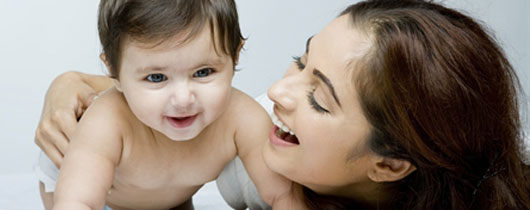Baby's vision at birth
A newborn's eyesight undergoes quite a few changes in the very first month. A baby is born with peripheral vision. By peripheral vision, we mean the capacity to see through the sides or edges and not straight. However, babies quickly also develop the capacity to focus at points and objects that are in center of their field of vision. They have a tendency to focus at objects that are between 8-15 inches in front of them. Their visual acuity grows quite fast and by the end of first month they can focus as far as 3 feet.
How baby's vision grows?
When a baby is born, she is very sensitive to flashy and bright light. This happens because at birth, baby’s pupils are quite small and constricted. After 10-15 days, the pupils begin to grow and enlarge in size. It is at this time that a baby starts seeing shades and patterns more clearly. The more contrast in pattern, the more the baby will get attracted to it. As an experiment, show the baby exactly same toys in three different shades: red, yellow and blue. The baby, most probably, would look at the red-colored toy. It is still not clear why this happens. Some argue it is because of greater contrast, but there is not scientifically-proven answer for this phenomenon so far. However, our understanding of baby’s vision is much more today than what it was a few years ago when her vision was described simply as blurs of light and dark. Hundreds of studies have since revealed a great deal about infants' preparations. Although the newborn's visual range is limited to between eight and twelve inches, she works hard to focus on an object within her line of vision. Once she "gets hold" of it, seeing is clearly a pleasure for the baby; her eyes brighten, she becomes very quiet, staring intently. Move the object slowly from side to side and she moves her head jerkily, trying to keep it in sight. Soon she'll try to follow if it's moved very slowly up and down.
Baby's visual preferences
Moreover, present-day baby can show you her preferences in modern art. If you don't want to tote him around a museum, try her on a series of prints or posters. She'll select boldly abstract designs with strongly delineated stripes and angles. The newborn concentrates longer on these than on solid shapes or patterns of diffuse colors. Her taste runs to pure colors, with a preference for red or yellow, rather than blends or pastels. And her overall favorite for study may prove to be a black and white graph of anything at all, perhaps of changes in the birth rate or the value of the Rupee.
Sometimes you'll find your baby enjoying "toys" that she's discovered for herself. She seems to be listening intently; the room is quiet; then you too hear the light, rhythmic plumping of your percolating coffee. You notice her gazing steadily in one direction; what has she found? Perhaps this time it's the interesting contrast of light and dark lines on a Venetian blind, or the moving patterns playing on a curtain where sunlight is filtering through the leaves of a tree outside.
Vision and baby's interest
If you want to prove to yourself how much seeing means to your baby and can bring yourself to tease her just a bit, try this experiment when she's alert and contentedly surveying her world. Place your hand an inch or two in front of her eyes to block her vision. She'll quickly look off to the side to unblock her view; if you continue to cut it off she'll continue her escape tactics. Very young infants are fairly good at this. But six week olds are skilled players, shifting head and eyes rapidly till you of course terminate the game.
What human face means to a baby?

The most heartwarming test is the newborn's interest in gazing at your face. It must be admitted that she doesn't know "who" you are, but from the very beginning in the first days of life, babies show more interest in the human face than in anything else. A picture of a face won't do for long; babies want the real thing. Perhaps movement plays a part in this preference. So babies like being with someone who can look at a baby "makes faces," lifts the eyebrows, smiles, moves the mouth in coos and chirps. Shiny objects attract the newborn too, making a person's eyes of great interest. If you hold your baby in semi-sitting position, this will increase her alertness. Then cup her head in your hands, face to face she'll make eye-to-eye contact with you, often for a remarkably long period. Authorities agree that there is much more than visual attraction involved here. There is paramount interest in the human face which displays the newborn's inborn tendency to sense how important a human being is to her. Parents, in turn, are drawn closer to the baby by her interest in gazing at them.

